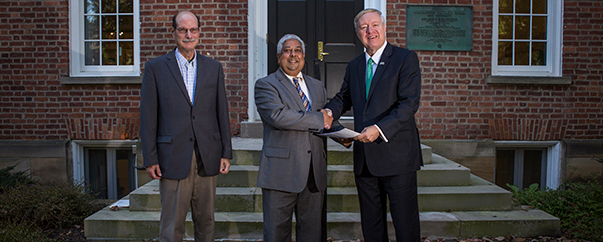AEP Foundation awards $300,000 to Voinovich School environmental programs
The American Electric Power (AEP) Foundation recently awarded $300,000 in grants for environmental programs at the Voinovich School of Leadership and Public Affairs at Ohio University.
AEP provided $250,000 for the Renewable Energy and STEM Education in Rural Appalachia Ohio program and $50,000 for the Watershed Education and Research program.
“AEP Ohio and Ohio University have a history of strong partnerships,” said Selwyn Dias, AEP Ohio vice president for distribution operations. “AEP Ohio is proud to support the Voinovich School in its latest effort to bring hands-on Renewable Energy and STEM education experiences to high school students. Showing students science, technology and engineering in the real-world is certain to get them excited about STEM careers. We are eager to see the impact of the program on students in the region.”
AEP created the Foundation in 2005 to support education, environment protection, and arts and cultural heritage programs in its service area. The Foundation has underwritten work at the Voinovich School since 2004, offering grants to the Appalachian Watershed Research Group (AWRG), a multidisciplinary group working together across Ohio University, as well as environmental education programs for schools throughout southeastern Ohio.
“We are grateful for the AEP Foundation’s continued funding, which reinforces and supports Ohio University’s long-term emphasis on not only watershed research and education, but also an expansion into the important arena of renewable energy. The Voinovich School’s focus on building lasting external partnerships, like with AEP Foundation, brings together multiple stakeholders in public-private partnerships to make important impacts in the region, state and nation,” Ohio University President M. Duane Nellis said.
The Watershed Education program will use its funding to enhance a watershed education website for teachers that includes lesson plans, access to 360-degree images of streams and wetlands and instructional videos. The platform also will feature a participation-based mapping program called “My Backyard Stream.” Using the program’s tools, students will be able to explore local streams in their communities and take pictures, collect water quality samples, and write descriptions of what they see.
“My Backyard Stream” has less to do with hard science than with fostering awareness of watershed ecosystems as a whole and helping students make an association to their place in the watershed, Jennifer Bowman, director of environmental programs, said.
“They’re going to see that connectivity, how upstream is connected to downstream,” she says.
It’s a difficult concept for young students to grasp, but when they do, they see more than the connections between waterways, she said. Tools like “My Backyard Stream” show students how they are connected to each other and how their choices affect the overall environment.
Wellston City Schools will be the first to use “My Backyard Stream” when it launches later this fall; other schools will join in the spring. The tool will improve as more schools use it, because the database will grow; students will be able to see a map of stream images and water quality data that spreads across the region.
AEP’s grant for the STEM and Renewable Energy program will fund educational programming on the “Internet of Things” as well as research into anaerobic digestion, solar energy and geothermal energy for future classroom curricula.
To teach students about the Internet of Things, Elkan Kim, senior computer software and data visualization engineer, and Stephanie Howe, associate director for human capital and operations, are building a doll-sized smart home. This smart home is not a toy, however. Sensors throughout it will help students to connect their behavior at home to energy usage and environmental issues, making the smart home an important educational tool. The eventual goal is to develop an in-depth, interdisciplinary curriculum using Internet of Things technology. Three high schools in Pike County will be first to implement the curriculum.
“They’ll show them how to wire and set up the smart home to monitor usage of appliances in the house,” Bowman said. “It’s simulating a regular house and the draws of energy we have and how that can be monitored and changed and tracked with smart devices.”
The grant also will fund research by environmental studies graduate students on anaerobic digestion, solar energy and geothermal energy. Aided by Voinovich School and College of Arts and Sciences faculty, they will translate their work into lessons for regional students.
The sizable grant for the Renewable Energy and STEM education program reflects changes in the AEP Foundation’s funding priorities, Bowman said, and will benefit students both at Ohio University and in area K-12 schools.
“AEP’s shift from coal-fired power plants to renewable energy sources is happening at our utilities level. Now it needs to happen at our research and education level, too,” she said. “My hope is to be able to build a robust renewable energy research program that students can plug into, like we already have with our watershed research,” she says.
The Appalachian Watershed Research Group’s educational programming is based on more than two decades of research into watershed connectivity and the impacts of acid mine drainage and other water quality threats. With past funding from AEP, the group has helped 10 regional watershed groups, mentored university students conducting water quality assessment and restoration projects, and worked with regional community and agency partners to restore 82 stream miles to meet biological targets.
She hopes AWRG will be an example for renewable energy efforts. “We can develop the renewable energy group as a working group that is an engine to support that work for the next decade,” she said.
